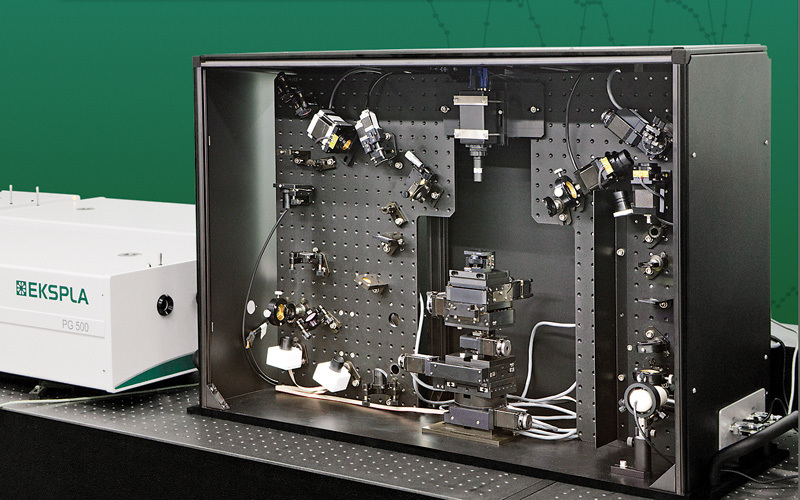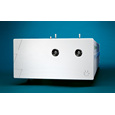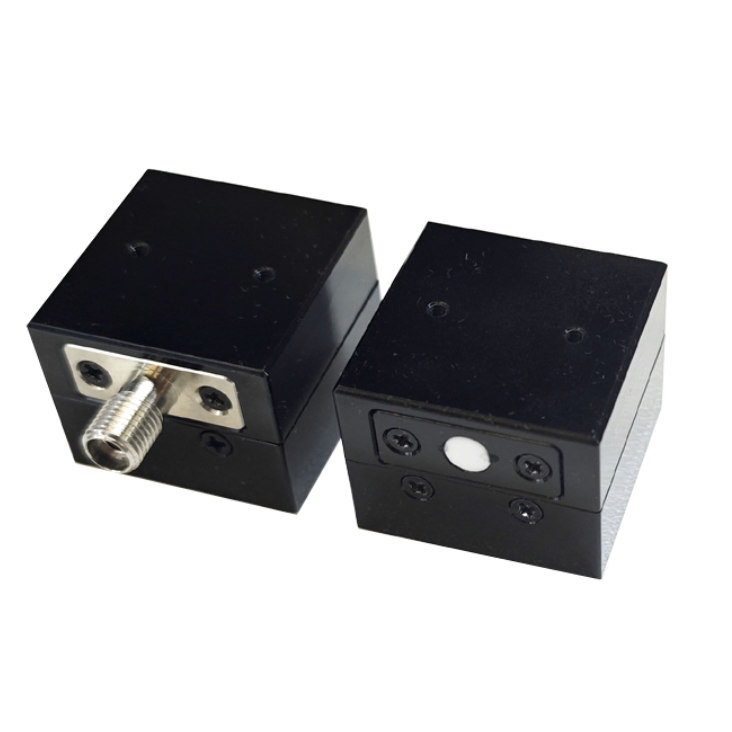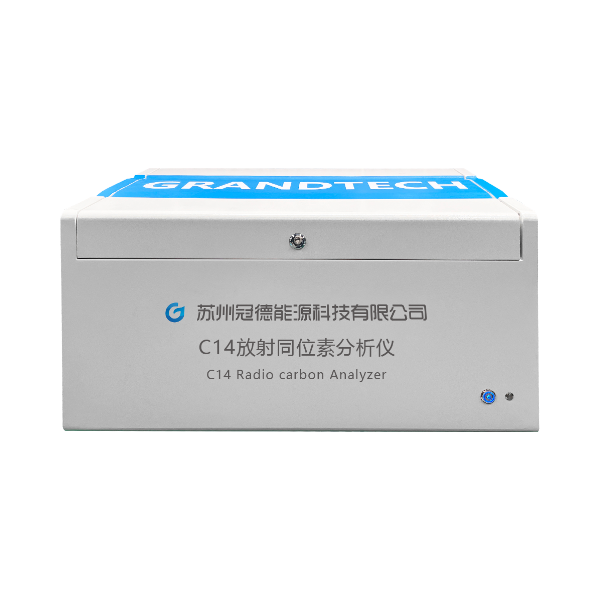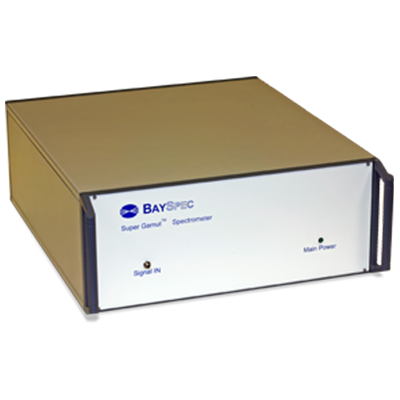采用Ekspla由30皮秒20赫兹30毫焦激光器,皮秒光学参量振荡放大器PG401和参量差频器构成的振动和频光谱(SFG)测量系统,对液滴撞击覆盖LB(Langmuir-Blodgett)膜表面的动力学过程进行了研究和分析
方案详情

ResearchGate doi numberJ.Braz. Chem. Soc., Vol.00,No. 00, 1-7, 2015.Printed in Brazil-@2015 Sociedade Brasileira de QuimicaArticle0103-5053 $6.00+0.00 See discussions, stats, and author profiles for this publication at: https://www.researchgate.net/publication/283876002 Dynamics of Drop Impact Against SurfacesCovered with Langmuir-Blodgett Layers Article in Journal of the Brazilian Chemical Society· January 2015 DOI: 10.5935/0103-5053.20150248 CITATIONS0 READS 20 3 authors, including: Paulo Barbeitas Miranda Edvaldo Sabadini University of Sao Paulo University of Campinas 61 PUBLICATIONS 2,564 CITATIONS 62 PUBLICATIONS603 CITATIONS SEE PROFILE SEE PROFILE Some of the authors of this publication are also working on these related projects: Analysis of the organic-metal interface in architectures of devices common to organic electronicsView project Molecular interaction between chitosan and cell membrane models investigated by nonlinearvibrational spectroscopy View project All content following this page was uploaded by Edvaldo Sabadini on 11 January 2016. Dynamics of Drop Impact Against Surfaces Covered with Langmuir-Blodgett Layers Natalia Goncalves," Paulo B. Miranda and Edvaldo Sabadini*a "Departmento de Fisico-Quimica, Instituto de Quimica, Universidade Estadual de Campinas(UNICAMP), 13083-970 Campinas-SP, Brazil bInstituto de Fisica de Sao Carlos,Universidade de Sao Paulo,P.O. Box 369,13560-970 Sao Carlos-SP, Brazil The dynamics of sucessive impacts of water droplets against flat glass surfaces covered byLangmuir-Blodgett films of zinc stearate with 1,3, 5 and 7 layers was investigated. The structure andresistance of monolayers to the impact was evaluated by using fast images of the drop deformation,Brewster angle microscopy (BAM) and contact angle measurements. Eventual disruption (erosion)of the layers was investigated by using sum-frequency vibrational spectroscopy (SFG). Keywords: erosion of monolayers, sum-frequency vibrational spectroscopy, wettability Introduction The impact of droplets on solid surfaces has been widelystudied due to the numerous interests of application, suchas the study of erosion by rain drops, by inkjet printing,spray cooling on hot surfaces, pesticides application oncrops, etc. In this specific case, the study of drop impactof solutions of pesticides against the surface is importantdue to the fact that many leaves have high hydrophobicity.Therefore, a significant portion of the agrochemical solutiontends to be ejected from the leaf and fall to the ground. Due to advances in technologies for high speedphotography, drop-surface impact investigations have beenhighly improved over the years. When colliding against asurface, the droplet undergoes a sequence of deformationsin the range of milliseconds, changing the total solid-liquidinterface energy in this short time interval.This energy istotally related to the physico-chemical characteristics ofthe drop and the surface. There are several known super hydrophobic surfaces innature. In 1997, Barthlott and Neinhuis’ related for the firsttime the super hydrophobicity and self-cleaning property of alotus leaf (Nelumbo nucifera) to its rough and waxy surface.Since then, several studies have been conducted in order toreproduce synthetic surfaces with similar properties. In order to mimetize the natural structures, severaltechniques have been used to produce super hydrophobicsurfaces. The main ones are: lithography, template, eletrospinning, sol-gel,’ electrochemical deposition,deposition by chemical evaporation (CVD), Langmuir-Blodgett,10-12 among others. The Langmuir-Blodgett technique is a simple method toproduce thin organic films on substrates and allows, beyondthe control of film thickness, a high degree of molecularorganization.It is very difficult to obtain this high levelof control over the orientation and arrangement of themolecules in the formation of layers by other depositionmethods. The dynamics of droplet impact against solid surfaceshas been widely studied, and driven by many industrialand fundamental interests.4 From a fundamental point ofview, the wealth of concepts that need to be considered inthe approach to this process is immense, from rheologyto interface chemistry.The result of the impact of fallingdroplets depends on several factors such as the impactspeed, the direction onto the surface, the droplet size,liquid properties (density, viscosity, viscoelasticity andsome other non-Newtonian effects for rheologicallycomplex fluids) and the surface tension.1 Furthermore, thestudy of the impact of drops on solid surfaces is complex,because besides the aforementioned factors, one shouldalso consider the nature of the surface of impact, such aswettability and roughness.16,17 When impinging against the surface, the dropletundergoes a sequence of deformations in the range ofmilliseconds, changing, in this brief interval, the energy ofthe solid-liquid interface of the systeml5 and, depending ontheir kinetic energy, surface hydrophobicity, and chemical nature of the liquid, part of the droplet can be ejected afterrebound. The present investigation aimed at studying theimpact of water droplets against hydrophobic surfaces.These surfaces were obtained by monolayer depositionof zinc stearate on glass using the Langmuir-Blodgetttechnique (LB). The main goal was to evaluate how thechemical nature of the solid surface may influence thedrop deformation after impact, as well as evaluating theresistance of the monolayers to eventual erosion. Thelatter was evaluated by the drop deformation, liquid-solidcontact angle and sum-frequency spectroscopy (SFG),before and after consecutive impacts. The uniformity ofthe films before impact was investigated by Brewster anglemicroscopy (BAM). Experimental Substrate pre treatment The solid supports used in this experiment for depositionof monolayers were glass slides. First of all, substrates werecleaned with chloroform in order to remove possible fatspresent on their surface. Then, they were dipped in ethylalcohol in a ultrasonic bath for 5 min. The plates weretransferred to a beaker containing distilled water, andremained immersed until use. Chemicals and solutions All solvents and reagents were used without furtherpurification. Solution of stearic acid (octadecanoic acid, Aldrich,99% purity) was prepared in chloroform at a concentrationof 1.0 mmol L-. Aqueous subphase for the LB-transferwas prepared by dissolving 0.1 mmol L- of zinc acetate(Aldrich, 99.99% purity) in ultrapure water (Millipore,resistivity 18.2 MQ cm). Langmuir-Blodget (LB) films The isotherms and LB deposition were carried outusing a computer-controlled trough from INSIGHTwith a surface area of 459 cm’. Prior to the experiment,the trough was rigorously cleaned with pure water andchloroform. The trough was then filled with the subphaseand thermostated at 20°C. Subsequently, 150 uL of stearicacid (SA) solution was spread onto the subphase to forman interfacial film. Around 5 min are allowed in order tothe solvent be evaporated and the SA layer to spread beforeinitiating the compression and transfer. The SA monolayers were compressed to a surface pressure of 30 mN m-andtransferred to the substrate by vertical dipping method witha deposition rate of 0.042 mm s-. A drying time of 10 minwas used after each lift/dip. Fast imaging of drop impact and image treatment The images of the droplet impact on the surfaceswere obtained using the experimental apparatus shownschematically in Figure 1. Figure 1. Scheme of the experimental apparatus used to generate thedrops and image acquisition:(1) fluid reservoir tube (burette); (2) valveto release drop; (3) lighting system; (4) ruler; (5) impact base; (6) cameraand (7) computer. The valve is opened and the droplet is formed slowly,detaching from the burette spontaneously. The droplet fallsfrom a height of 60 cm and collides with the surface.A LEDlight (blue) system was used for illumination. Three consecutive shocks were filmed in the same spotof the flat glass. After each impact, the droplet was carefullyremoved from the surface with a tissue by capillarity, takingdue care so that it does not touch the glass surface. All tests were performed in duplicate with two differentplates prepared under the same experimental conditions.The images were obtained using a digital high-speedcamera (Photron 1024PCI CMOS model 100KC),coupledwith an objective lens Nikon zoom (1x). The images wereobtained at 6000 frames s. The images were processed using Image J software(MacBiophotonics, http://www.macbiophotonics.ca/downloads.htm). The contact areas (solid-liquid) betweenthe droplet and the surface were determined at differenttime intervals during expansion and contraction of thedroplet on the surface. Contact angle The determination of the contact angle between thewater droplet and the different surfaces was performed using an optical tensiometer (Theta, Science Biolin). Thecontact angles (at the equilibrium) of water droplets (15 uL)on cover slips with different numbers of monolayers wereobtained before and after the three impacts. SFG spectroscopy A commercial SFG spectrometer (Ekspla, Lithuania)was used for the nonlinear vibrational spectroscopymeasurements. Its source is a Nd+:YAG laser (1064 nm)with 30 ps pulses of ca. 30 mJ and 20 Hz repetition rate.For sample excitation, the wavelength in the visibleregion was 532 nm (corresponding the 2nd Harmonicof the laser) with an average energy of 900 uJ and 60°incidence angle, and an infrared beam tunable in the range1000-4000 cm- with an average pulse energy between 30and 150 uJ, and incidence angle 51°. The polarizations ofthe beams used were SFG (s); Vis (s);IR (p). The overlaparea of the visible and IR beams on the sample wasabout 1 mm². The spectral region of interest in this workwas the CH stretching (2800 to 3000 cm), which wasscanned at intervals of 3 cm-l with each data point beingan average of 100 laser shots. The spectral resolution ofthe IR pulse generated by the optical parametric amplifierand difference frequency generation stage was 3 cm.The SFG measurements were obtained before and afterthree impacts, at the same point in the glass covered withmonolayers. Brewster angle microscopy (BAM) A commercial BAM microscope (Nanofilm GmbH) wasused for imaging the transferred monolayers and assessingtheir homogeneity. Results and Discussion A sequence of photographs obtained after the impactof a drop against the bare surface of glass and coveredwith a certain odd number of monolayers (n) are shownin Figure 2 and a film of a drop impact can be seen in theSupplementary Information (SI) section. The spreading of the drops takes approximately 4 msand no important variations on the morphology of thedroplet area are observed for the surfaces. However, theretraction of spread liquid is sensitive to the coverage. Atthe end of the process, a shallow film remains spread at thesurfaces for n=0 and 1, indicating certain wettability. Whenn > 1, the rim of the disk is more fragmented for surfacescovered with more than three layers, in comparison withthe disk of liquid retracting on the glass surface. time/ Glass 3 5 7 Figure 2. Sequence of photos obtained after the impact of droplets againstglass surface and on glass surface covered with 1, 3,5, and 7 monolayers.At the left are indicated the times (in ms) after the first contact of the dropwith the surface in which the photos were taken. The result obtained with the surface covered by asingle layer (n= 1), has motivated to understand if thewettability was consequence of irregular coverage or it isrelated to the fragility of the monolayer. The impact couldcause erosion of the monolayer, partially exposing thedrop of water to the glass surface. In order to investigatethe capability of the monolayers to resist against eventualerosion caused by the drop impact, sequences of impactsover the same area were filmed. For better analysis of thetemporal development of the film diameter spread on thesurface. some considerations must be made. It is commonin the literature (see references 18 and 19) to express thedynamics in dimensionless parameters. Therefore, the timeis converted to t* =tV/D (t=time, V=the initial impactvelocity of the drop,D= the initial drop diameter). In orderto use a dimensionless diameter, the spreading factor isused, which is defined by d*= d/D (d= diameter of thecontact area of the liquid on the surface, D=the diameterof the droplet before impact).2.18,19 These transformationsare essential when comparing the behavior of droplets ofdifferent liquids impacting on several solid surfaces. In thispaper, only impacts of water droplets were studied, but theseconsiderations are still necessary in order to avoid possiblevariations in size of droplets formed in each impact andcamera positioning during the filming. Furthermore, thisprocessing provides better visualization of the results incomparison with previously data reported in the literature. The dependence of the expansion factor, d*, of theliquid in different times (normalized) for the surfaces isplotted in Figure 3. Dimensionless time (t* =tV/D) Dimensionless time (t*=tV/D) 70 Glass oP ll v 口 口 口 口 分 v 贝 (d) o 0 10 20 30 40 50 60 Dimensionless time (t*= tV/D) Figure 3. Dependence of the expansion factor as a function of time for a sequence of three impacts (I, II and III) on surfaces covered with:1 (a); 3 (b); 5(c) and 7 (d) monolayers. The result for the impact against the bare-glass surface is also indicated as a reference. The reproducibility of the whole process was investigatedby filming the drop impact in two independent experiments.The impacts of two drops against two surfaces with thesame number of layers were filmed. During the expansionprocess, the variation of the expansion factor is lower than5% but larger differences (35%) were observed during thedrop retraction. Except for the surface with n=1, the results for theconsecutive impacts over the other covered surfacesrevealed that the spreading-contraction processes arenot significantly affected by the sequence of drops. Thismeans that under such experimental conditions, the layersare apparently resistant to disruption by drop impact.Conversely, the damage may result in the removal of abilayer, maintaining the same wettability overall. Therefore, the increased wettability for the single layerfilm (n=1) suggests that the monolayer transfer to the glasssurface is not complete. We have confirmed this by takingimages of the films with BAM. An example is shown in Figure 4, but all films have shown the presence of partialcoverage, with regions of different film thicknesses. This explains why the single layer film presents largerwettability and susceptibility to damage by drop impact,while the other films with n>1 are more hydrophobic andresistant to damage. The many layers eventually cover allthe glass surface, presenting only hydrophobic alkyl chainsexposed to air, and eventual damage possibly remove onlythe additional layers that are weakly bonded to the first one. The contact angles of sessile drops of water positionedon the regions of the impacts were determined, in order toverify changes of the wettability caused by destruction ofthe monolayers (Figure 5). The values for contact angles obtained for the surfacesare shown in Table 1. The results of the contact angle are in agreement withthe observations of the spreading-contraction processobserved in the films. The surface covered with only onemonolayer is indeed more wetted in comparison with the Figure 4. BAM image of a 3-layer LB film of zinc stearate on glass,before drop impact. The image size is 300 (H)×375 (V) um. Brighterregions correspond to thicker films. The nearly vertical pattern of finelines is an artifact due to interference of the laser reflection on the backside of the substrate. Figure 5. Pictures of sessile drops on surfaces of glass, and over surfacescovered with 1, 3, 5 and 7 monolayers, before and after the impact ofthree drops. Table 1. Values for the contact angle (°) for water on glass and on surfacescovered with n layers of Zn Stearate without impact and after the impactof three drops Number of layers (n) Without impact After three impacts Glass (0) 44±4 70±3 57±5 3 76±2 66±2 5 86±2 85±1 7 93±2 88±1 surfaces containing more layers. The values for the contactangle increases with the number of layers, indicating aprogressive hydrophobicity. This can be associated withcertain inhomogeneity of the layers, as seen in the BAMimages (Figure 4). The transfer rates (TR) observed duringthe depositions were: 0.5-0.7 and 0.9-1.1 for even and oddnumbers of monolayers, respectively. Although we haveused in our experiments only films with odd numbers oflayers (that are hydrophobic), during their fabrication theeven layers, being less perfect, do affect the quality of thefinal odd-layered film. According to the results, the contactangle of the surfaces covered with 1 and 3 layers changeto lower values of contact angle after 3 drop impacts, butnegligible variation is observed for 5 and 7 layers. The inhomogeneity during the preparation of themonolayers and eventual modification caused by dropimpact were investigated by using Sum-frequency generationvibrational spectroscopy (SFG spectroscopy). This (non-linear) vibrational spectroscopy is appropriate to investigatemolecular orientation at interfaces, as only the spectrum ofa non-centrosymmetric media is obtained.20.21 Therefore,based on this condition, the homogeneity of lipid layers ona glass plate can be investigated. In Table 2 are indicated thevibrational modes for CH, and the terminal CH, groups ofalkyl chains and their correspondent wavenumbers. Table 2. Wavenumbers and correspondent stretching modes for the CHgroups of alkyl chains observed by SFG2 Mode Frequency/ cm Symmetric stretching of CH, ca. 2878 Fermi resonance of CH. ca. 2940 Anti-symmetric stretching of CH, ca. 2965 Symmetric stretching of CH, ca. 2848 Anti-symmetric stretching of CH, ca. 2915 For a surface perfectly covered with a densely packedmonolayer (for which TR=1) the peaks associated withthe stretching of the terminal -CH,group dominates thespectrum, because the modes of the CH groups alongthe chain are inactive due to their centrosymmetricalarrangement.? For an even number of densely packedZn stearate layers (not used in this work), they form acentrosymmetrical arrangement and no SFG spectrum isdetected. Therefore, in the ideal case of perfectly transferredlayers, the films with even number of layers would showvanishing SFG signals and those with odd numbers shouldall yield the same spectrum, dominated by contributionsfrom the terminal CH, group of the last layer.23.24However,if a layer is not densely packed, the alkyl chains presentgauche conformations that break the inversion symmetry of the CH, groups along the chain, so that the SFG spectrumhas now contributions from both CH, and CH, groups.Hence, the intensity ratio for the CH, and CH, symmetricstretches is a qualitative indicator of the conformationalorder of the monolayers.22.25 Figure 6 shows the SFG spectra for the plates coveredwith the Zn stearate layers before the drop impact. Thepeaks associated with the vibrational modes listed inTable 2 are indicated.According to the spectra of Figure 6a(and Figure 6b), the intensity of the peaks increases withthe number of layers. The SFG intensity for the 7-layerfilm is nearly the same for a perfect LB monolayer. Aspreviously mentioned, this trend would not be expected forperfectly ordered layers,and therefore is associated withsome inhomogeneity produced during the transfer of themonolayers to the plate, probably more pronounced for theeven numbers, as indicated by their lower transfer ratio andthe BAM images (see Figure 4). The SFG spectra for the surfaces covered with one andseven layers,before and after the impact of three droplets, Number of layers Figure 6. (a) SFG spectra for the glass surface covered with several Znstearate layers (the attributions of the correspondent stretching modes areindicated according to Table 2); (b) intensity of the peak associated withthe symmetric stretching of CH, as a function of the number of layers. are shown in Figure 7. Contrary to the surface coveredwith only one layer (Figure 7a), negligible variations areobserved in the spectra for the seven-layer film (Figure7b)after the impact of the drops. Figure 7. SFG spectra for the surfaces covered with (a) one and (b) sevenlayers, before and after the impact of three droplets. For the seven layers, the SFG spectra indicate theyare nearly perfect densely packed before and after theimpacts. We infer that in this case, the interactions betweenthe molecules of stearate preserve the integrity of themonolayer under such impact conditions. However, asmall decrease of the CH, symmetric stretch (2878 cm-)and increase of the CH, symmetric stretch (2848 cm-) areobserved for the one-layer film. This indicates that filmsalready with partial coverage and gauche defects have theconformational disordered of the alkyl chains increased,possibly due to the erosion caused by the drop impact. Conclusions The fast images of the droplet deformation obtainedafter their impact against surfaces covered with LB layers of Zn stearate revealed that their spreading mechanismin independent of the nature of the surface. However, theretraction is sensitive to variations on the nature of thesurface. For the impact on surfaces covered with only oneLB monolayer of partial coverage, the surface is morewettable in comparison with surfaces covered with morelayers. Under the experimental drop impact conditions, theLB monolayers revealed to be very resistant to the eventualerosion caused by sequence of drop impacts, except forthe more wettable one-layer film. The results based onthe fast images of the drop deformation,are supported bymeasurements of SFG spectroscopy, in which the integrityof the external layer is evidenced. Supplementary Information A film of a drop impact against a glass surface coveredwith Langmuir-Blodgett monolayers of zinc stearate canbe seen in Supplementary File available free of charge athttp://jbcs.sbq.org.br as wmv file. Acknowledgments The authors thank the Brazilian agencies CNPq, andFapesp for financial support and fellowship. We alsothank Professor Maria Elisabete D. Zaniquelli for thepreparation of the LB substrates, Thais Cristina Destefanifor the experiments of drop impact used in the picture ofthe Graphical Abstract and Iveraldo Rodrigues for his helpwith the pictures. References ( 1. Scheller , B. L . ;Bousfield, D . W.;AIChEJ. 1995,41,1357. ) ( 2. Wirth, W.; Storp, S.; Jacobsen, W.; Pestic. Sci. 1 9 91, 33, 411. ) 3. Barthlott, W.;Neinhuis, C.; Planta 1997, 202, 1. ( 4. Zhang, X.; Zhao, J . ;Z h u, Q.; Chen, N. ; Zh a ng, M.; Pan, Q.;ACS Appl. Mater. Interfaces 2011,3,2 6 30. ) 5.Abdelsalam, M. E.; Bartlett, P. N.; Kelf, T.; Baumberg, J.;Langmuir 2005,21, 1753. 6. Muthiah, P.; Hsu, S. H.; Sigmund, W; Langmuir 2010, 26,12483. 7. Manca, M.; Cannavale, A.; De Marco, L.; Arico, S. A.;Cingolani,R.; Gigli, G.; Langmuir 2009, 25,6357. ( 8. Darmanin,T.; Guittard,F.; J. Am. Chem. Soc.2009,131,7928. ) ( 9 . Meng,L. Y . ; Park, S . J.; Mater . Chem. Phys. 2012, 132,324. ) 10. Roberts, G. G.; Langmuir Blodgett Films; Plenum Press: NewYork, 1990. 11. Puggelli, M.; Gabrielle, G.; Caminati, G.; Thin Solid Films1994,244,1050. 12. Gabrielle, G.; Puggelli,M.; Ferroni,E.; Carubia,G.;Pedrocchi, L.; Colloids Surf.1989, 41,1. 13. Uzunoglu, T.; Capan,R.;Sari,H.; Mat. Chem. Phys. 2009,117,281. 14. Klein, J.; Nature 2000, 405, 745. ( 15. Frohn, A.; Roth, N.; Dynamics of Droplets, S pringer-Verlag: Berlin, 2000. ) ( 16. Y arin, A . L.; Annu. R ev. Fluid Mech. 20 0 6, 38, 159. ) ( 1 7 . Tsai,P.; Pacheco, S.; Langmuir 2009,20, 1 2293. ) ( 18.Rioboo, R . ; Marengo, M. ; Tr o pea, C. ; Exp. Fl u ids 2002,33, 1 1 2. ) ( 19. Sikalo, S.; Ganie, E . N.; Exp . Therm. Fluid Sci. 2006, 31,97. ) 20. Shen, Y. R.; PNAS 1996,93,12104. ( 21. L ambert, A. G.; Da v ies,P. B . ; Neivandt, D. J.; Appl. Spectrosc. Rev. 2005, 40, 1 03. ) ( 22. Guyot-S i onnest, P; Hu n t, J. H.; Shen, Y. R .; Phys. Rev. Lett. 1987,59,1597. ) ( 23. N ishida, T.; Johnson, C. M.; H olman, J.; Osawa, M . ; D a vies,P. B.; Ye, S.; Phys. Rev. Lett. 2006, 96,077402. ) ( 24. Silva, H. S.; M iranda, P. B .; J. Phys. Chem. B 2009,113 , 7491. ) ( 25. K eszthelyi, T.; Holl6, G.; Nyitrai, G.; Ka r dos, J.; Heja, L.; Langmuir 2015,31, 7815. ) ( Submitted: August 1 2, 2015 ) Published online: September 22, 2015 FAPESP has sponsored the publication of this article. The user has requested enhancement of the downloaded file. *e-mail: sabadini@iqm.unicamp.br The dynamics of sucessive impacts of water droplets against flat glass surfaces covered byLangmuir-Blodgett films of zinc stearate with 1, 3, 5 and 7 layers was investigated. The structure andresistance of monolayers to the impact was evaluated by using fast images of the drop deformation,Brewster angle microscopy (BAM) and contact angle measurements. Eventual disruption (erosion)of the layers was investigated by using sum-frequency vibrational spectroscopy (SFG).
确定

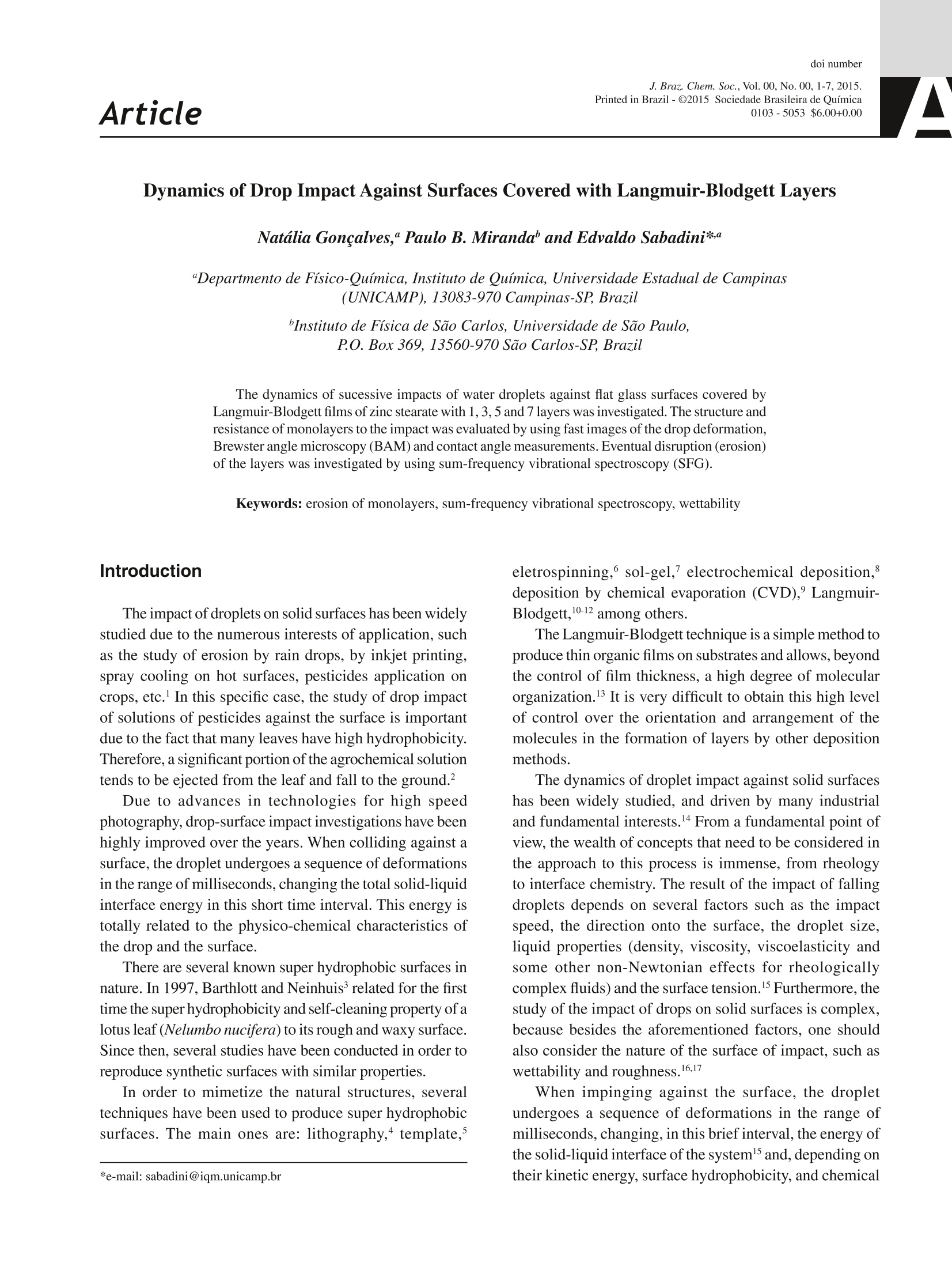

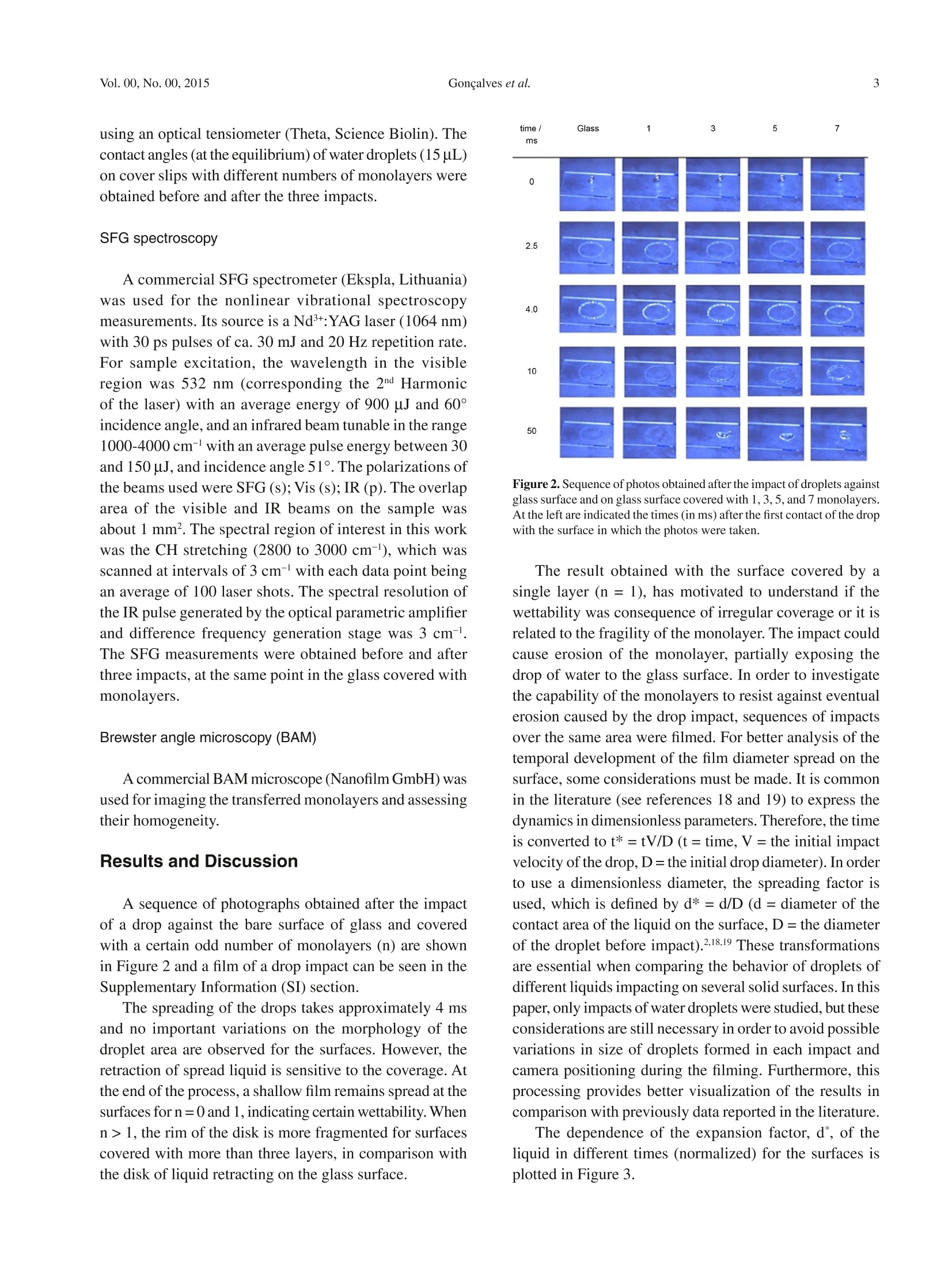

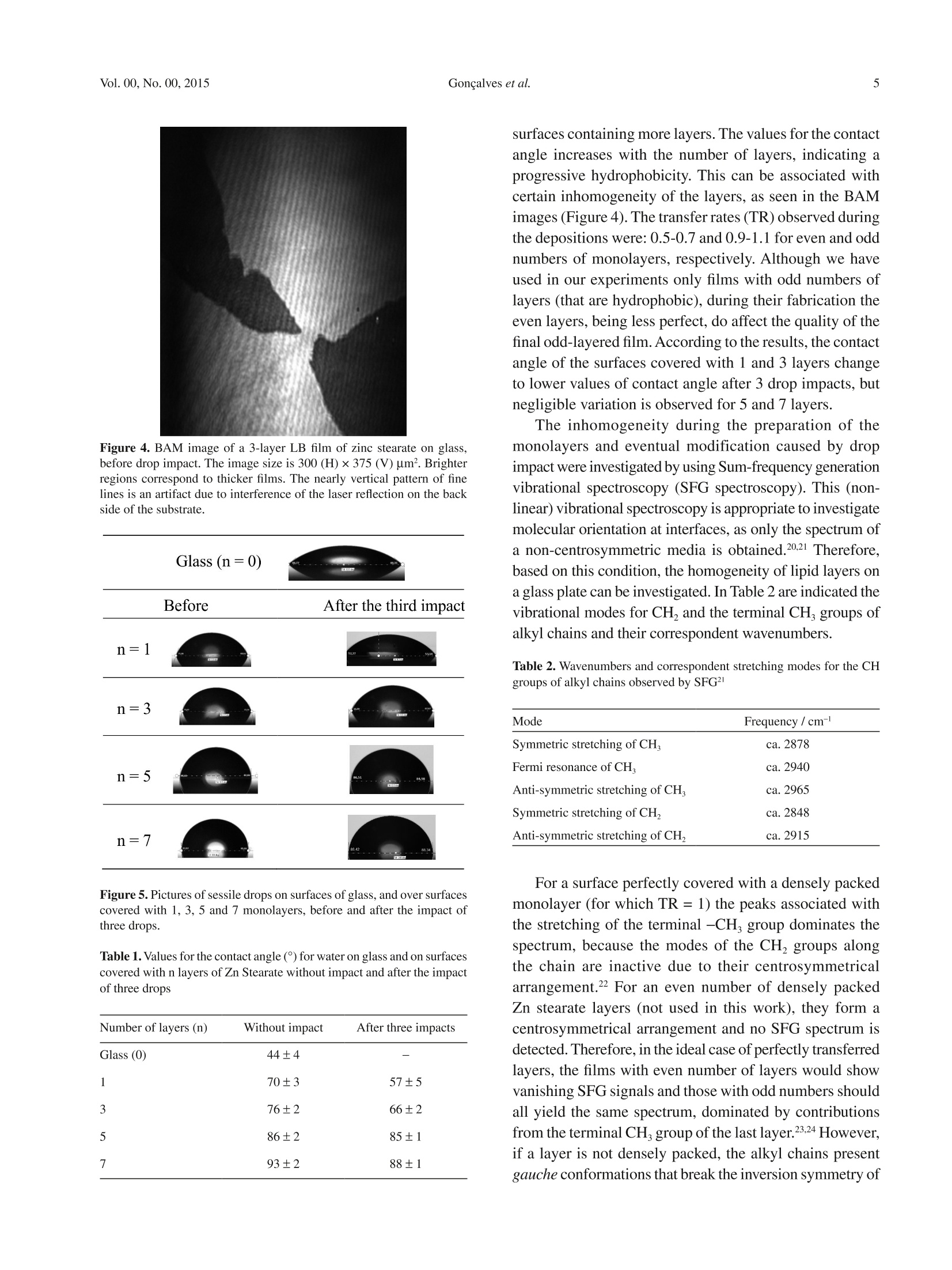
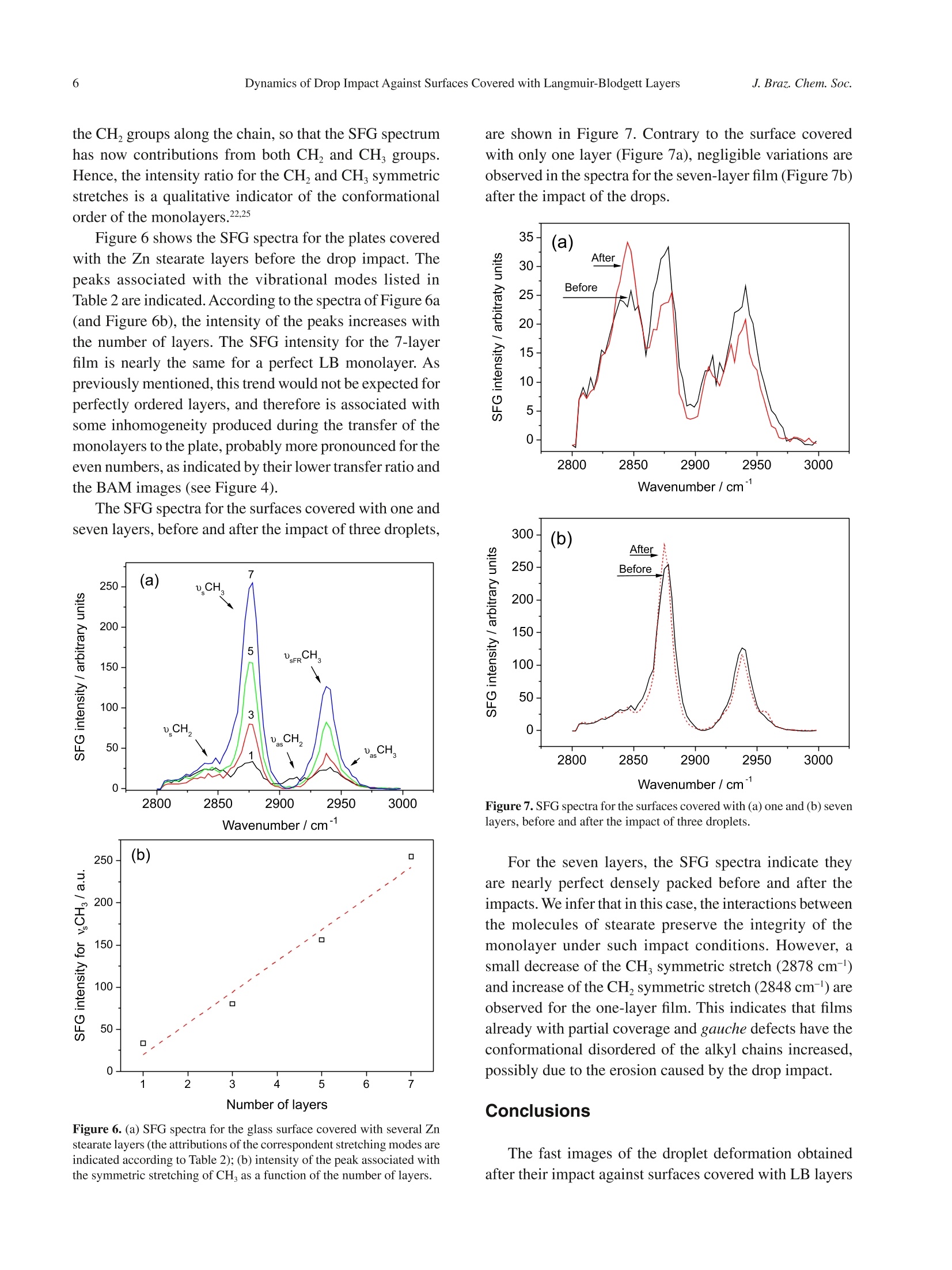
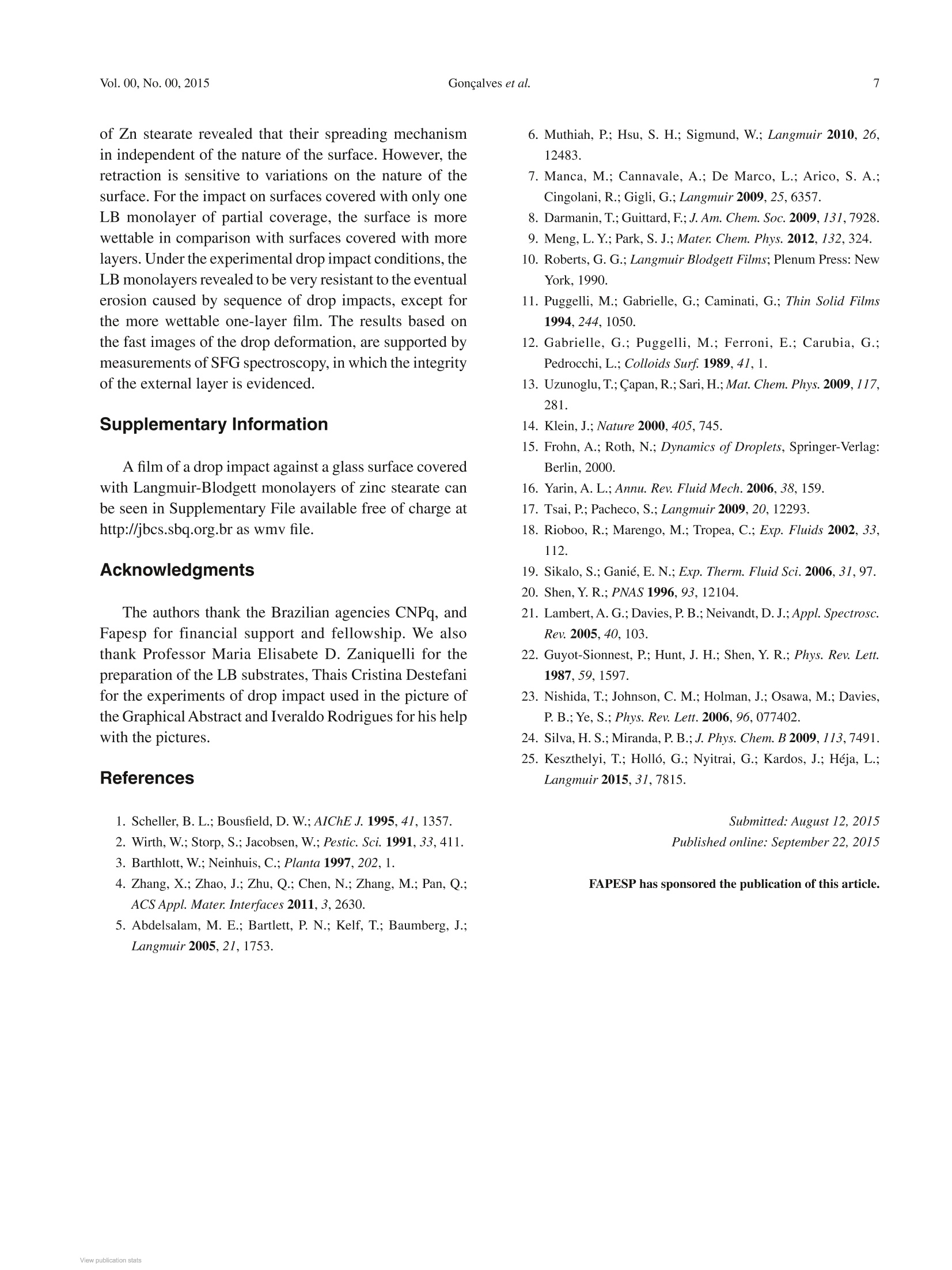
还剩6页未读,是否继续阅读?
北京欧兰科技发展有限公司为您提供《LB(Langmuir-Blodgett)膜表面,液滴中动力学过程检测方案(其它光谱仪)》,该方案主要用于其他中动力学过程检测,参考标准--,《LB(Langmuir-Blodgett)膜表面,液滴中动力学过程检测方案(其它光谱仪)》用到的仪器有Ekspla SFG 表面和频光谱分析系统、Ekspla PGx01 皮秒光学参量发生器(OPA)
推荐专场
相关方案
更多
该厂商其他方案
更多

